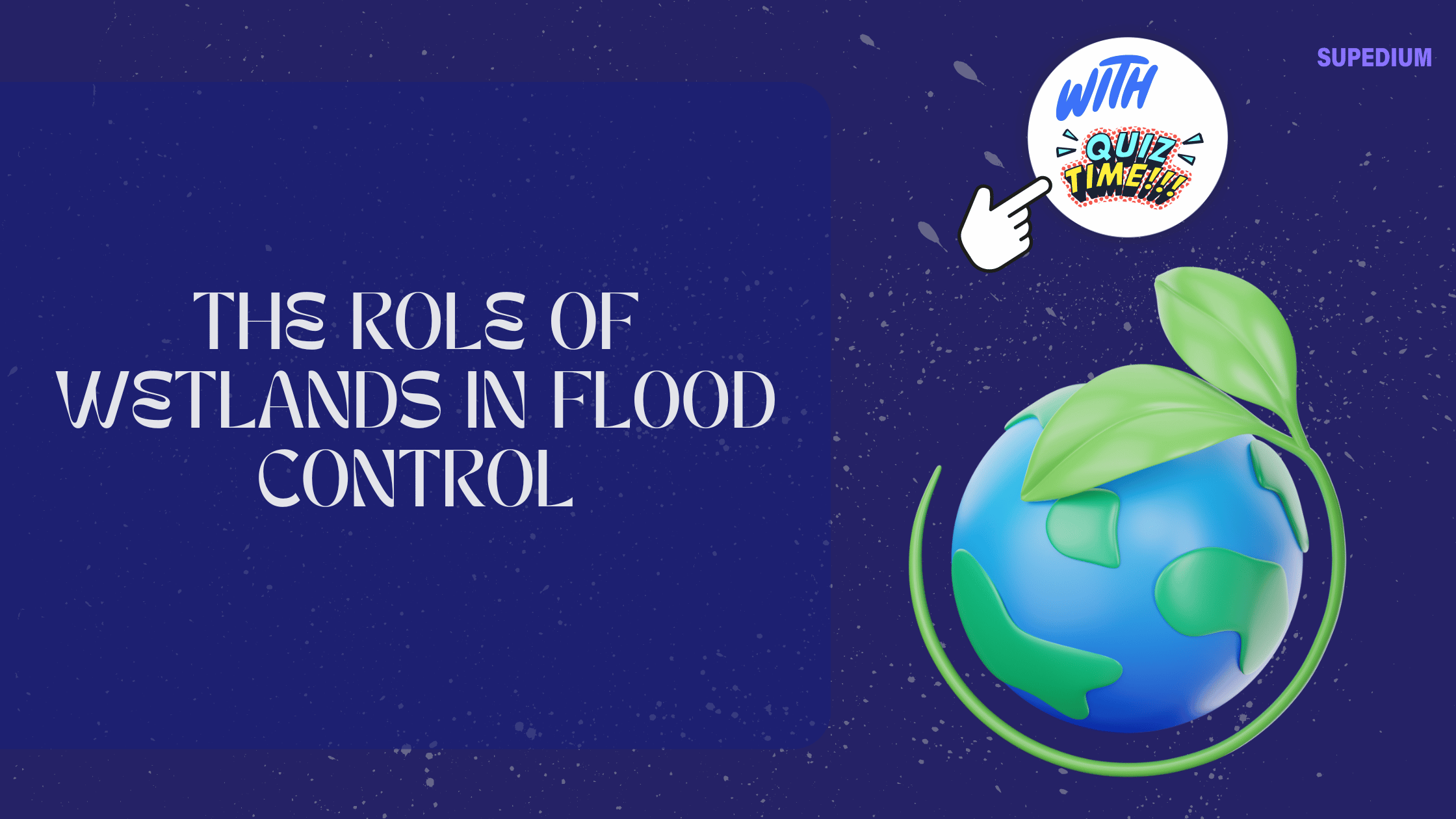Table of Contents
![]()
Introduction
Wetlands are unique and vital ecosystems characterized by their waterlogged soils and specialized plant and animal life. They include marshes, swamps, bogs, and fens, each with distinct features but sharing core functions. Wetlands play an essential role in maintaining ecological balance, providing habitat, filtering water, and sequestering carbon. However, one of their most critical functions is flood control. This article explores how wetlands contribute to managing floodwaters, the mechanisms involved, and the impact of human activities on their effectiveness.
Understanding Wetland Ecosystems
Types of Wetlands
Wetlands come in various forms, each with its unique characteristics:
- Marshes: Dominated by herbaceous plants such as reeds and cattails, marshes are often found in floodplains and along the edges of lakes and rivers.
- Swamps: These wetlands are characterized by the presence of trees and shrubs, such as cypress and mangroves, and are often located in low-lying areas with slow-moving water.
- Bogs: Bogs are acidic wetlands with peat-forming vegetation like sphagnum moss. They are usually found in cooler climates and have a distinctive, slow decomposition process.
- Fens: Fens are nutrient-rich wetlands with a diverse array of plant species, including grasses and sedges. They often have higher water pH levels compared to bogs.
Wetland Functions
Wetlands provide several critical functions:
- Water Storage: Wetlands can hold large amounts of water, acting as natural reservoirs that absorb and store excess rainwater.
- Nutrient Cycling: They play a crucial role in nutrient cycling, filtering pollutants and excess nutrients from runoff before they enter larger water bodies.
- Habitat Provision: Wetlands offer habitats for a diverse range of species, from insects and amphibians to birds and mammals, supporting biodiversity.
Mechanisms of Flood Control
Wetlands are instrumental in flood control through various mechanisms:
Water Absorption and Retention
Wetlands possess the capacity to absorb and retain water due to their unique soil composition and vegetation. The soil in wetlands, often composed of clay and organic matter, has a high water-holding capacity. Additionally, the vegetation, including grasses and shrubs, helps slow down the flow of water and increases infiltration rates. This combination allows wetlands to absorb excess rainwater and reduce the volume of water entering downstream areas.
Reduction of Runoff
Wetlands significantly reduce surface runoff. Their plant roots and soil structure enhance water infiltration, preventing rapid surface flow. This reduction in runoff decreases the likelihood of sudden, high-intensity floods, as the water is absorbed and gradually released.
Floodplain Storage
Wetlands act as natural floodplains, temporarily storing floodwaters and releasing them slowly over time. This storage capability helps mitigate the impact of floods by reducing the peak flow rates in rivers and streams, which can otherwise lead to severe flooding downstream.
Case Studies and Examples
The Everglades, USA
The Everglades, a vast wetland system in Florida, historically played a significant role in flood regulation. The slow-moving waters of the Everglades absorbed excess rainfall and regulated water flow into the region’s rivers and estuaries. However, land development and water management practices have altered the Everglades’ natural flow patterns. Restoration efforts aim to restore the region’s flood control functions by reestablishing natural water flows and enhancing wetland health.
The Okavango Delta, Botswana
The Okavango Delta is a seasonal floodplain that experiences annual flooding due to rainfall in the Angolan highlands. The delta’s wetlands store and slowly release floodwaters, supporting a diverse ecosystem and reducing flood risks in surrounding areas. The seasonal inundation provides crucial water resources for wildlife and local communities, demonstrating the delta’s role in managing regional flood dynamics.
The Amazon Basin, South America
In the Amazon Basin, extensive wetland areas contribute to regional flood control by absorbing and storing water during the rainy season. These wetlands help regulate river levels and mitigate the effects of extreme weather events. However, deforestation and climate change are threatening the basin’s wetlands, potentially exacerbating flood risks and impacting the region’s ecological balance.
Impacts of Human Activities
Land Conversion
Urban development and agricultural expansion have significantly impacted wetlands. Converting wetlands to other land uses reduces their flood control capacity by decreasing their water storage and absorption abilities. This alteration can lead to increased runoff and higher flood risks in areas previously protected by wetlands.
Pollution and Environmental Degradation
Pollution from agricultural runoff, industrial activities, and wastewater discharge can degrade wetland ecosystems. Contaminants can impair the ability of wetlands to filter water and maintain their natural functions. The resulting decline in wetland health can reduce their effectiveness in flood control.
Climate Change
Climate change affects wetlands through altered precipitation patterns and rising sea levels. Changes in rainfall can lead to more intense storms and flooding, challenging the ability of wetlands to manage these increased water volumes. Rising sea levels can also result in the loss of coastal wetlands, reducing their flood mitigation functions.
Conservation and Restoration Efforts
Wetland Protection Policies
National and international regulations play a crucial role in wetland conservation. Policies such as the Ramsar Convention, which aims to protect wetlands of international importance, and various national laws, help safeguard wetland areas. Conservation programs focus on preserving existing wetlands and preventing further degradation.
Restoration Projects
Restoration projects seek to rehabilitate degraded wetlands and reestablish their natural functions. Techniques include reintroducing native vegetation, restoring natural water flows, and removing invasive species. Successful restoration can enhance flood control capabilities and improve overall wetland health.
Community Involvement
Local and indigenous knowledge is vital in wetland conservation. Engaging communities in conservation efforts and raising public awareness about the importance of wetlands can foster stewardship and support for sustainable management practices.
Future Directions and Research
Emerging Technologies
Advancements in remote sensing and monitoring technologies offer new tools for studying and managing wetlands. Techniques such as satellite imagery and geographic information systems (GIS) help track wetland changes and assess their flood control functions. Modeling and simulation can predict the impacts of various scenarios on wetland ecosystems.
Integrating Wetlands into Urban Planning
Incorporating wetlands into urban planning through green infrastructure approaches can enhance flood management. Designing urban areas to include natural water retention systems, such as wetlands and green roofs, can reduce flood risks and provide additional environmental benefits.
Continued Research Needs
Ongoing research is needed to understand the long-term impacts of environmental changes on wetlands. Addressing knowledge gaps regarding wetland functions and their responses to climate change and human activities will be crucial for developing effective management strategies.
Conclusion
Wetlands play a crucial role in flood control through their ability to absorb and retain water, reduce runoff, and provide floodplain storage. Despite their importance, wetlands face significant threats from human activities and climate change. Conservation and restoration efforts are essential to preserve these ecosystems and their flood management functions. By integrating wetlands into broader environmental and urban planning strategies, we can enhance their ability to mitigate flood risks and support ecological health.






Be the first to comment